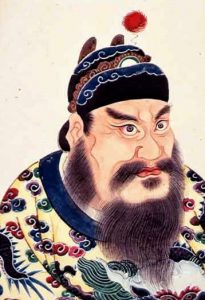The First Emperor
China's first emperor was named Qin Shi Huangdi. He brought together all the warring states and made them his subjects in 221 B. C. Qin is pronounced "Chin" and ever after the country was named China. He took the name Shi Huangdi which means "first emperor." Qin was an unusual man. He standardized writing, bureaucracy, scholarship, law, currency (money), and weights and measures. He built a capital and many roads. He connected the old walls along China's northern frontier to form the Great Wall, to protect his country from invaders. But he was also cruel. He killed and banished many people who disagreed with him and destroyed books from the past.
In 1974, archaeologists uncovered thousands of life-size terracotta (hard, red clay) warriors, each with a different face, near the tomb of the first emperor. He hoped he would live forever, but if he couldn't, he wanted these warriors to always be with him to protect him in the afterlife.
Chinese Inventions
Paper was first presented to the Emperor in 105 A. D., but archaeologists have found proof that it was used at least 200 years before that. Chinese used bamboo to make this early paper.
The Chinese had gunpowder as early as the 8th century A. D., long before the Europeans. They used gunpowder for weapons of war but also for fireworks. They had a moveable type for printing by 1045 A. D., but it did not change their society as much as Gutenberg's invention would three hundred years later in the West. This is because the Chinese language commonly uses 3000 or more characters, instead of the 26 in the English alphabet. That's a lot of pieces of type!
Chinese scholars had understood natural magnetism as early as 200 A. D. They learned how to magnetize iron ore (magnetite) by heating and cooling it just so. Magnets that were cooled in a north/south position would always face that way if they floated in a basin marked with directional points. Many Chinese ships were carrying compasses by the 11th century A. D.
If you need to find more information on this civilization (including crafts and other projects), check out the books, videos, and Web sites we've gathered for our ancient China list.



